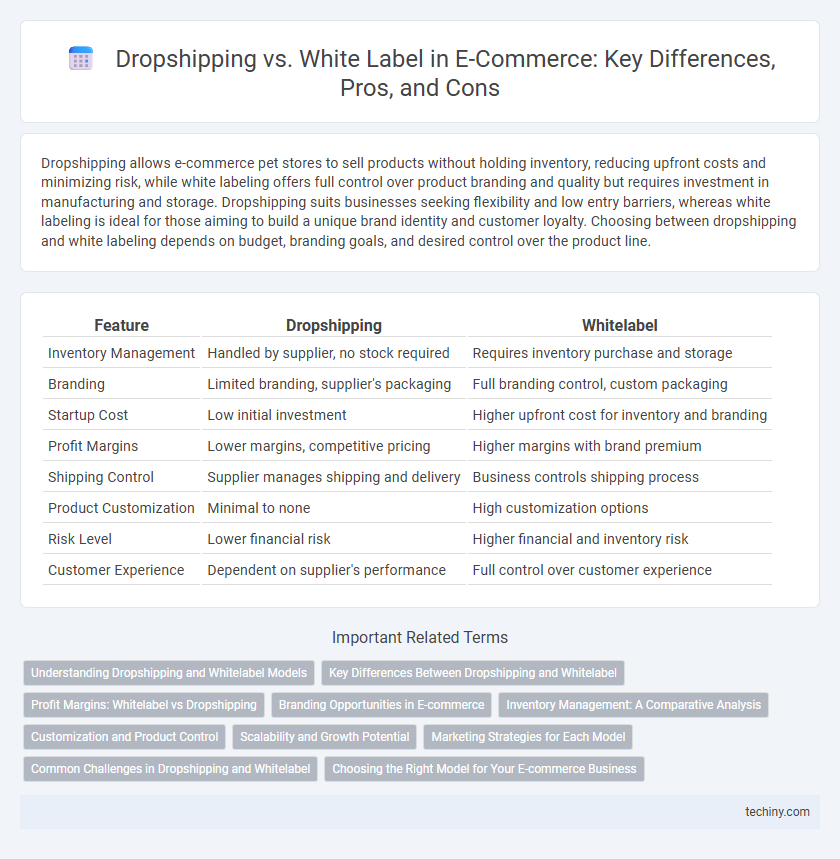Dropshipping allows e-commerce pet stores to sell products without holding inventory, reducing upfront costs and minimizing risk, while white labeling offers full control over product branding and quality but requires investment in manufacturing and storage. Dropshipping suits businesses seeking flexibility and low entry barriers, whereas white labeling is ideal for those aiming to build a unique brand identity and customer loyalty. Choosing between dropshipping and white labeling depends on budget, branding goals, and desired control over the product line.
Table of Comparison
| Feature | Dropshipping | Whitelabel |
|---|---|---|
| Inventory Management | Handled by supplier, no stock required | Requires inventory purchase and storage |
| Branding | Limited branding, supplier's packaging | Full branding control, custom packaging |
| Startup Cost | Low initial investment | Higher upfront cost for inventory and branding |
| Profit Margins | Lower margins, competitive pricing | Higher margins with brand premium |
| Shipping Control | Supplier manages shipping and delivery | Business controls shipping process |
| Product Customization | Minimal to none | High customization options |
| Risk Level | Lower financial risk | Higher financial and inventory risk |
| Customer Experience | Dependent on supplier's performance | Full control over customer experience |
Understanding Dropshipping and Whitelabel Models
Dropshipping allows e-commerce sellers to list products without holding inventory, as suppliers ship items directly to customers, minimizing upfront costs and reducing risk. Whitelabel involves branding generic products under the seller's own label, offering greater control over product quality, customization, and profit margins. Understanding these models helps entrepreneurs choose between flexibility with lower investment in dropshipping or higher branding potential and margin optimization in whitelabel strategies.
Key Differences Between Dropshipping and Whitelabel
Dropshipping involves selling products directly from suppliers without holding inventory, enabling low upfront costs but limited branding control. Whitelabel allows businesses to rebrand and customize products, requiring inventory investment but offering greater brand identity and customer loyalty. The primary differences lie in branding capabilities, inventory responsibility, and profit margins, with whitelabel providing higher customization at the expense of operational complexity.
Profit Margins: Whitelabel vs Dropshipping
Whitelabel products typically offer higher profit margins than dropshipping due to lower per-unit costs and greater control over branding and pricing strategies. Dropshipping margins are often slimmer because of reliance on third-party suppliers and increased competition, which can force price reductions. Businesses opting for whitelabeling benefit from enhanced scalability and stronger customer loyalty, directly impacting long-term profitability.
Branding Opportunities in E-commerce
Dropshipping offers limited branding opportunities since products are sold under the supplier's brand, restricting customization and customer loyalty development. Whitelabel allows e-commerce businesses to create and promote their own brand identity by customizing products, packaging, and marketing materials, enhancing long-term brand equity. Strong branding in whitelabel models drives customer retention and increases perceived value, which directly impacts profit margins and competitive advantage in the market.
Inventory Management: A Comparative Analysis
Dropshipping eliminates the need for inventory management by allowing sellers to fulfill orders directly from suppliers, reducing overhead and risk but limiting control over stock levels and shipping times. Whitelabel requires maintaining inventory, giving sellers complete control over product quality, packaging, and faster shipping but comes with higher upfront costs and storage responsibilities. Efficient inventory management in whitelabel can improve customer satisfaction and brand consistency, while dropshipping emphasizes flexibility and low investment.
Customization and Product Control
Dropshipping offers low upfront investment with limited customization since products are sourced from third-party suppliers, restricting control over product quality and branding. Whitelabel allows full customization and branding opportunities, giving sellers complete control over product design, packaging, and customer experience. Choosing whitelabel enables stronger brand identity and differentiation in competitive e-commerce markets.
Scalability and Growth Potential
Dropshipping offers low upfront costs and easy scalability by outsourcing inventory management, enabling rapid testing of diverse products without significant investment. White label requires more initial investment but provides greater control over branding and product quality, fostering stronger customer loyalty and higher profit margins for sustainable long-term growth. Scalability in dropshipping is limited by supplier reliability, while white label scalability depends on production capacity and marketing strategies.
Marketing Strategies for Each Model
Dropshipping marketing strategies rely heavily on social media advertising, influencer partnerships, and search engine optimization to attract customers without inventory investment. Whitelabel businesses focus on brand building through personalized packaging, customer loyalty programs, and targeted email marketing to differentiate products and enhance customer retention. Both models benefit from data-driven analytics to optimize ad spend and tailor marketing campaigns to niche audiences.
Common Challenges in Dropshipping and Whitelabel
Dropshipping often faces challenges such as supplier reliability, longer shipping times, and limited control over product quality, which can impact customer satisfaction and brand reputation. Whitelabel businesses encounter obstacles like higher upfront costs, inventory management complexities, and the need for strong branding efforts to differentiate products in a competitive market. Both models require efficient logistics, clear communication with suppliers, and strategic marketing to overcome operational hurdles and achieve sustainable growth.
Choosing the Right Model for Your E-commerce Business
Choosing the right e-commerce business model depends on factors such as control over branding, inventory management, and profit margins. Dropshipping offers low upfront costs and hassle-free inventory handling but limits customization and brand exclusivity. Whitelabel allows businesses to create proprietary products with higher profit potential, requiring greater investment in product sourcing and marketing.
Dropshipping vs Whitelabel Infographic

 techiny.com
techiny.com